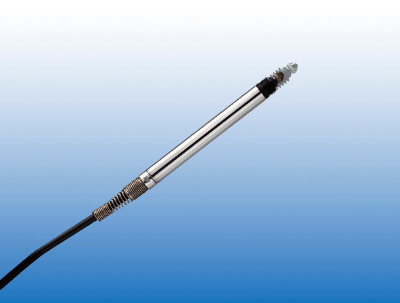What Is a Displacement Sensor?
 Displacement sensors are sensing devices that measure the thickness and height of the object itself.
Displacement sensors are sensing devices that measure the thickness and height of the object itself.
Contact-type sensors that measure by making contact with a probe and non-contact sensors that use lasers are available.
Uses of Displacement Sensors
Displacement sensors are widely used in industry. Displacement sensors are used to measure distances, especially in processing and conveying equipment, where the position and shape of the workpiece must be detected.
They are also useful in situations where thickness information of the object to be measured is required, such as in product appearance inspections. Although thickness can be measured with calipers, non-contact displacement sensors are used for products with complex shapes or products that are defective when touched.
Principle of Displacement Sensor
When measuring the distance to a certain object to be measured, either a diffuse-reflection or a normal-reflection laser displacement sensor is used. In either case, light from the laser light source is reflected off the surface of the object to be measured, and the distance is determined by detecting the reflected light at the photosensitive area.
The photosensitive area has a certain area width, and the photosensitive area varies depending on the angle of the reflected light. When the photosensitive area changes, a corresponding electric current is detected, and the distance is converted to a distance value based on this information.
Due to its structure, if the surface of the object to be measured is at an acute angle, the reflected light does not return to the photosensitive area and cannot be detected. This allowable tilt depends on the design of the displacement sensor, and in general, displacement sensors with the diffuse reflection method have a wider detection angle.
Types of Displacement Sensors
Displacement sensors are available in a wide range of products for different applications. The following are examples of displacement sensors.
1. Differential Transformer Displacement Sensor
The most typical sensor for detecting linear displacement by electromagnetism consists of a primary coil, two secondary coils, and an iron core between the coils; the primary coil acts as an exciter, the secondary coil as a detector, and the iron core is movable.
When high-frequency alternating current flows through the primary coil, electromagnetic induction induces a voltage in the secondary coil, causing the iron core to move. The moving iron core generates a voltage difference from a state of zero differential output, and this is the mechanism by which displacement can be measured.
The structural feature of this system is that the measured value rarely jumps. On the other hand, since it uses the magnetic field of the coil, the magnetic field characteristics may not be stable depending on the position of the iron core in the coil.
2. Linear Scale
Linear scales, also called linear encoders, are sensors used to measure positions and distances in a straight line with high accuracy. Two types of linear scales exist: inductosyn and magnescale.
Inductosyn consists of a fixed comb-shaped coil scale and a movable comb-shaped coil slider. When an alternating current is applied to the coil, a voltage is induced in the coil of the slider, and the displacement is measured from the change in phase.
Magnescale consists of a scale using magnetic tape or other magnetic recording media and a detection sensor. The position is detected by the movement of the detection sensor, and displacement is measured.
3. Synchronization
Synchro is a rotary angle displacement sensor that consists of two rotating shafts: a transmitter and a receiver. When an alternating current flows through the primary coil wound around the shaft on the transmitter side, electromagnetic induction induces a voltage in the secondary coil on the receiver side.
At this time, the shaft of the receiver rotates by the same angle as the shaft of the transmitter, and the rotational angular displacement is measured.
4. Resolver
Resolvers are sensors that detect the angle of rotation by electromagnetic induction. It consists of a coil for excitation, two coils for detection, and an iron core. All of these coils are in series.
When an AC voltage is applied to the excitation coil, a voltage is induced in the detection coil. Since the output voltage varies with the angle of rotation, the rotational angular displacement is measured from this output signal.
How to Select a Displacement Sensor
When selecting a displacement sensor, first check whether the application is distance detection or shape information detection. For distance detection, select a product that can measure more than the surface angle of the object to be measured from among those that match the measurement range. For thickness measurement, check the detection range.
The required measurement accuracy is then confirmed, and specifications for resolution, detection accuracy, and linearity are selected. All of these factors affect measurement accuracy, and in general, the higher the accuracy, the more expensive the product.
In addition to the measurement accuracy, the installation space is also checked. If the installation space is small, a smaller sensor is recommended.